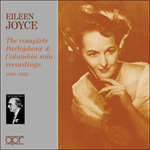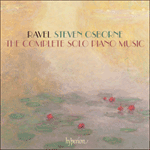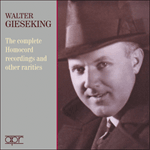Ravel marked himself out from most of his colleagues in his refusal to engage with Wagner—a great composer certainly, but dangerous as a model. Instead, he turned to Liszt, whom he regarded for one thing as a better orchestrator and, for another, as a piano composer on whom he could build. His
Jeux d’eau, finished in November 1901 and premiered by Ricardo Viñes on 5 April the following year, obviously invites comparison with Liszt’s
Les jeux d’eaux à la villa d’Este, and Ravel, asked how it should be played, answered ‘like Liszt, of course’. The epigraph, ‘Dieu fluvial riant de l’eau qui le chatouille’ (River god laughing at the water that tickles him), is taken from a poem by Henri de Régnier, who inscribed it on the earliest autograph of the piece: in fact the ‘Dieu’ of the quotation refers to the goddess Latona sitting naked on the back of a tortoise, as depicted on a fountain at Versailles. When the young pianist Henriette Faure played it to Ravel after the First World War, he complained: ‘Your fountains are sad ones.’ She repeated it, ‘thinking happy thoughts, so as to turn what I had previously thought was a meditation into a sparkling divertissement’. Ravel was content … and was quick to realize that he had found a new style of piano writing, to the point that he questioned the primacy in this area of Debussy, ‘who at the beginning of 1902 … had written only the three pieces
Pour le piano [which], from the purely pianistic point of view, say nothing really new’.
from notes by Roger Nichols © 2011
Un domaine où Ravel s’est démarqué de la plupart de ses collègues a été son refus de s’engager aux côtés de Wagner—un grand compositeur certes, mais dangereux comme modèle. À la place, il s’est tourné vers Liszt qu’il considérait d’abord comme un meilleur orchestrateur et aussi comme un compositeur de musique pour piano dont il pouvait tirer parti. Ses
Jeux d’eau, achevés en novembre 1901 et créés par Ricardo Viñes le 5 avril de l’année suivante, suscitent visiblement la comparaison avec les
Les jeux d’eaux à la villa d’Este de Liszt, et Ravel, à qui quelqu’un demandait comment il fallait les jouer, a répondu «comme du Liszt, bien entendu». L’épigraphe, «Dieu fluvial riant de l’eau qui le chatouille» est tirée d’un poème d’Henri de Régnier, qui l’a inscrite sur la première partition autographe de la pièce: en fait, le «Dieu» de la citation fait référence à la déesse Latone assise nue sur le dos d’une tortue, telle qu’elle est représentée sur une fontaine à Versailles. Lorsque la jeune pianiste Henriette Faure l’a jouée à Ravel après la Première Guerre mondiale, il s’est plaint: «Vos Jeux d’eau ils sont tristes». Elle l’a rejouée «en pensant joyeusement afin de transformer ce que je croyais être une contemplation en un divertissement plus lumineux». Ravel était content … et a vite compris qu’il avait trouvé un nouveau style d’écriture pianistique, au point de remettre en question la suprématie de Debussy dans ce domaine, [de qui] «au commencement de 1902 … il n’existait … que les 3 pièces
Pour le piano [qui], au point de vue purement pianistique, n’apportaient rien de bien neuf».
extrait des notes rédigées par Roger Nichols © 2011
Français: Marie-Stella Pâris
Ein Gebiet, auf dem Ravel sich von der Mehrheit seiner Kollegen unterschied, war seine Verweigerung, sich mit Wagner auseinanderzusetzen—gewiss ein großer Komponist, doch ein gefährliches Vorbild. Stattdessen orientierte er sich an Liszt, den er zum einen als den besseren Orchestrierer und zum anderen als einen Klavierkomponisten betrachtete, auf den er bauen konnte. Seine
Jeux d’eau, die im November 1901 fertiggestellt und von Ricardo Viñes am 5. April im folgenden Jahr uraufgeführt wurden, fordern den Vergleich mit Liszts
Les jeux d’eaux à la villa d’Este heraus und auf die Frage, wie sein Stück aufgefasst werden sollte, antwortete Ravel: „Wie Liszt natürlich“. Das Epigraph, „Dieu fluvial riant de l’eau qui le chatouille“ (Flussgott lacht über das Wasser, das ihn kitzelt) stammt aus einem Gedicht von Henri de Régnier, der es auf das älteste Autograph des Stückes schrieb. Tatsächlich ist mit dem „Dieu“ aus dem Zitat die Göttin Latona gemeint, die—entsprechend der Darstellung auf einem Wasserspiel in Versailles—nackt auf dem Rücken einer Schildkröte sitzt. Als die junge Pianistin Henriette Faure Ravel das Werk nach dem Ersten Weltkrieg vorspielte, beklagte er sich: „Ihre Wasserspiele sind traurig.“ Sie wiederholte es und „dachte an fröhliche Dinge, so dass das, was ich zunächst als Meditation verstanden hatte, sich in ein glänzendes Divertissement verwandelte“. Ravel war zufrieden—und stellte schnell fest, dass er einen neuen Kompositionsstil für das Klavier gefunden hatte. Er stellte sogar die Vorrangstellung Debussys auf diesem Gebiet in Frage, „der zu Beginn des Jahres 1902 … lediglich die drei Stücke
Pour le piano geschrieben hatte, [die] von einem rein pianistischen Standpunkt her nichts wirklich Neues beitrugen“.
aus dem Begleittext von Roger Nichols © 2011
Deutsch: Viola Scheffel


 Eileen Joyce - The complete Parlophone & Columbia solo recordings
Eileen Joyce - The complete Parlophone & Columbia solo recordings Ravel: The Complete Solo Piano Music
Ravel: The Complete Solo Piano Music Walter Gieseking - The complete Homocord recordings and other rarities
Walter Gieseking - The complete Homocord recordings and other rarities
